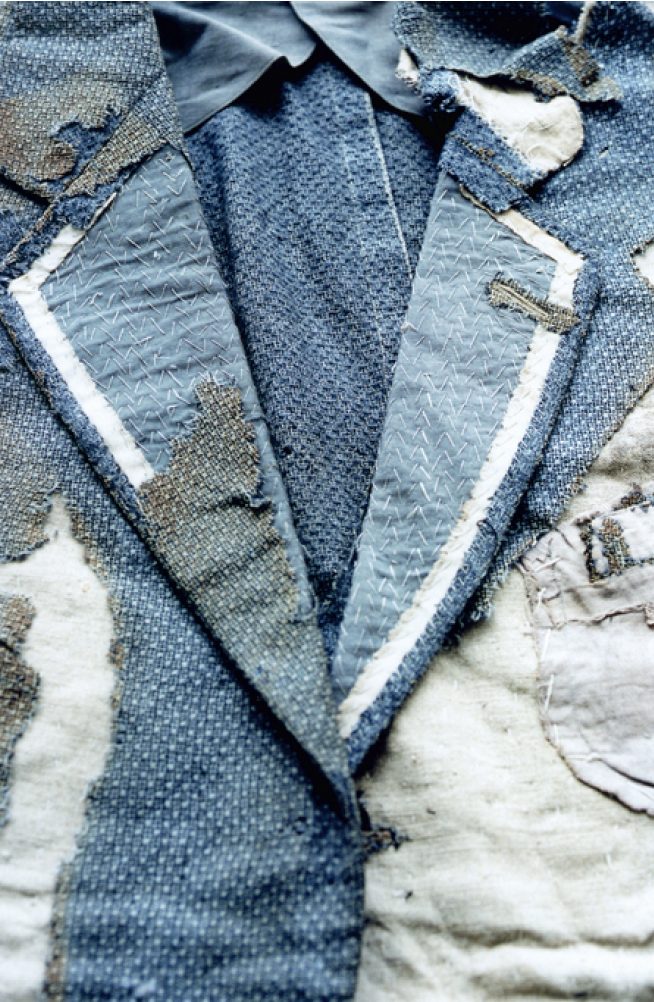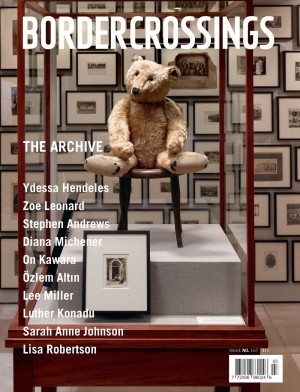Ishiuchi Miyako
Since the middle of the 20th century, a couple of place names have been branded on our consciousness, summarizing in their few searing syllables the unimaginable atrocities that human beings are capable of. Auschwitz is one such name. Hiroshima is another. Yes, there were other Nazi death camps, and a second Japanese city was obliterated by an American atomic bomb, but the magnitude of slaughter and suffering that those first two places represent has positioned them as the most potent markers of their time.

Ishiuchi Miyako, ひろしま #24 Man’s jacket, 2007–2008, C-type print, 1080 x 740 cm. Images courtesy UBC Museum of Anthropology, Vancouver.
Ishiuchi Miyako’s series of colour photographs, titled “ひろしま hiroshima by Ishiuchi Miyako,” attempts to transcend the incomprehensible immensity of the event—more than 100,000 people died from the explosion of a single atomic bomb over Hiroshima on that sunny August morning in 1945—to focus on the particular and the personal. One of Japan’s leading contemporary photographers, Ishiuchi has chosen as her subject the clothing, accessories and personal effects left behind by victims of the atomic blast and now housed in the Hiroshima Peace Memorial Museum. Her intention, she has stated, is to release these objects from their history—or, rather, from the way their history has been “calcified.” Instead of depicting Hiroshima as a mass grave of undifferentiated humanity, the 48 photographs in the exhibition—the images of clothing especially—speak to the individual everydayness and the beauty of life before the blast.
Ishiuchi’s photos are a record of her very personal, rather than political, responses to the artifacts she encountered. In a video running in the gallery, she recounts that she spoke to the test photos from this series when they were tacked to the wall of her studio. It’s as if these articles were themselves living creatures, Ishiuchi says. It’s obvious, too, that they function as embodiments or surrogates of the individuals who owned them, the men, women and children who wore the clothes, boots and slippers, the rings, watches and school uniforms, the gloves and underwear and stockings, on the last day of their earthly existence.
Shooting with a handheld camera, Ishiuchi recorded these objects as they were individually laid out on a light table or a white backdrop, so that they are isolated within their shallow, silvery, almost weightless frames. Often, too, she has focused on telling details: the beautifully woven fabric or lively floral pattern of a woman’s dress, the brightly coloured buttons on a cotton tunic, the lines of delicate hand stitching on the waistband of a blouse, even the careful patching of a worn, cotton glove. All these details assert both the individual taste and the resourcefulness of people making the most out of wartime conditions and deprivations. Again, they represent Ishiuchi’s desire to express an enduring sense of beauty in the everyday.

Ishiuchi Miyako, ひろしま #82 Glasses, 2007–2009, C-type print, 230 x 335 cm.
At the same time, the damage inflicted upon these garments and accessories is heart-stoppingly appalling, directly correlative to the damage inflicted upon their unseen wearers. Shreds of charred, torn and blood-stained clothing, a blackened line of lace, the perma- nently fogged lenses of a pair of broken glasses, the melted face of a camera, all bear witness to unimaginable horror. There’s something unspeakably tragic about an air-raid hood fashioned out of old kimono fabric, its surface pitted with burns. Bound into this one object, of course, is the fact that it would have provided no protection at all against the heat and radiation that killed its wearer. Part of the horror of the atomic bombing of Hiroshima was the impossibility, for its citizens, to anticipate it in any way, or to know what was happening when it occurred.
From our vantage point, 66 years later, we know exactly what was happening. That’s why it’s impossible to look at the fragile fragment of a girl’s school jacket, identifiable by the name patches still stitched to its upper sleeve and bodice, without gasping with emotion. Blackened and wispy, revealing faint traces of its original white-on-blue pattern, this blasted ghost of a garment was discovered hanging on a bridge. The body of the girl who wore it was never found. Still, the young woman who owned the one-piece undergarment, whole, but charred black (Ishiuchi shoots it in its entirety, along with a close-up of its English-language manufacturer’s label), reportedly survived her burns by jumping into a river.

Ishiuchi Miyako, ひろしま #7 Dress, 2007–2008, C-type print, 1080 x 740 cm.
Such stories, however, are not recorded in the exhibition. Instead, the framed photos are hung in stepped groups in the gallery, without any explanatory labels. A list of works is given in the brochure that accompanies the exhibition, but the designations are min- imal: “chemise” or “baby’s dress” or “slippers.” And although the brilliant white light behind them, along with the near-transparency of many of the seared fabrics, seems to reiterate the blinding light of the atomic blast, Ishiuchi says no, that’s not what they’re about. The use of the light table is a reference to her previous series of photo- graphs in which she examined her late mother’s personal effects, such as clothing and cosmetics, evoking as she did so both the body and its absence. Part of her strategy in “Mother’s” was to hang the garments in a window before shooting them, suspending them in a flood of natural light.
In much of her recent work, Ishiuchi has recorded the traces of time and trauma on the human body, and she continues that pro- ject here. But has she succeeded in releasing the subjects of her photo- graphs from their history? I’m not so sure. There’s still too much emotion and horror bound into these artifacts, reactions that have entirely to do with their history, or at least with the way we contemplate the obliteration of so many people, the suffering of the injured, the pain endured by those who survived. Yet, there is also an element of transcendence here. Some of the more gossamer garments, suspended in the light, could be the souls of the dead. They could be butterflies, that ancient and enduring symbol of transformation and rebirth, fluttering upward. Out of the reaches of that death-dealing day. ❚
“ひろしま hiroshima by Ishiuchi Miyako” was exhibited at the UBC Museum of Anthropology in Vancouver, from October 13, 2011 to February 12, 2012.
Robin Laurence is a Vancouver-based writer, curator and contributing editor to Border Crossings.

